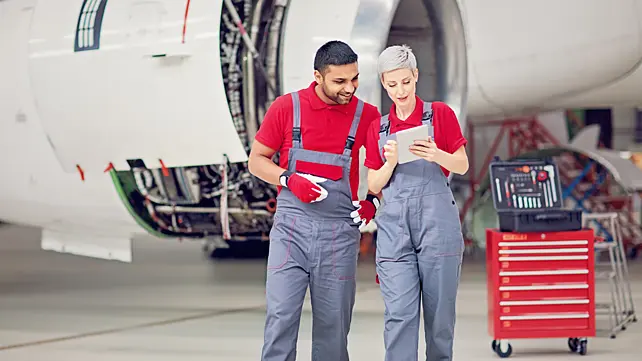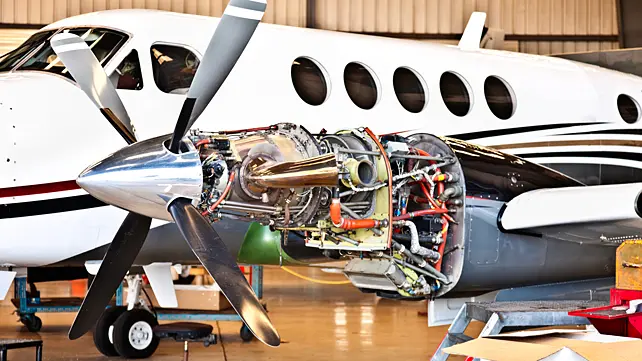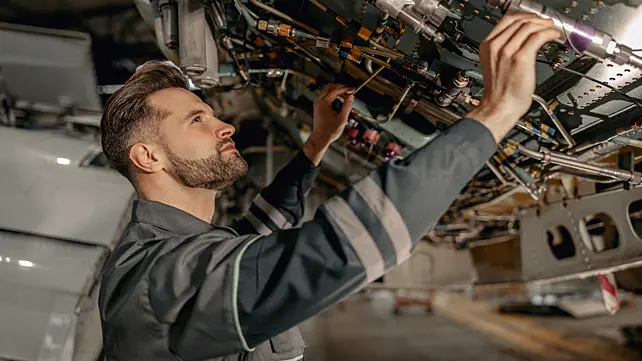
The Maintenance, Repair, and Overhaul (MRO) sector has a very crucial role to play in the aerospace and defence industry. It directly reflects not just the airworthiness of an aircraft but also the health of the economy. In simple words, aircraft grounded due to maintenance is a loss across the value chain and the economy at large.
With India expected to become the world’s third largest civil aviation market as per IATA (International Air Transport Association), and its ongoing defence modernisation plan pegged to make it a large market for defence aircraft, a capable indigenous MRO sector becomes imperative to support both the commercial as well as the defence sector.
However, India’s indigenous MRO sector is still in a nascent stage with heavy dependence on imports. As per a report by Deloitte, 90% of the current MRO requirements in India are dependent on imports. And it is expected to continue until the Indian MRO sector tightens its belt in terms of size, efficiencies, and bouquet of services.
While expanding size and bouquet of services could be the near future for the Indian MRO sector, operational efficiencies backed by digital transformation is a low-hanging fruit.
“We are witnessing the MRO sector leveraging the current situation as an opportunity, to accelerate digital transformation rather than slowing them down. There were projects held back before COVID-19 due to operational priorities and decision-making delays, which are now being brought forward. There have been investments on focused initiatives around predictive maintenance, paperless MRO, planning and scheduling optimisations to control costs and improve efficiency,” explained Saravanan Rajarajan Saran, Director, Aviation Consulting, Ramco Systems.
Indicating that the MROs generate a wealth of data pertaining to the aircraft engine defects, parts consumed, labour hours and elapsed time to carry out the repair and overhaul procedure, Saran pointed out how this accumulated data over time “can become a goldmine of information to gain insights.”

Therefore, what digitalisation serves is two purposes – one it makes processes efficient and reduces turnaround time, putting aircrafts back into action fast and economy healthy. Secondly, it exposes the sector to data insights and learnings that can be utilised to build capabilities.
'We believe the confluence of AI/ML, advanced analytics, mobile and 5G technologies will be game changers and enable MROs to achieve higher operational efficiencies. This may involve bringing together Electronic Flight Bags (EFBs), mobile & wearable technologies, embedded IOT, external systems, their ERP systems and seamlessly interlinking them,” said Saran.
By accumulating a wealth of structured and unstructured data, and embracing these technological advancements, MROs are well poised to operate efficiently with the resources they have, he added.
Aircraft Check Is Complex Work
The MRO sector is vast and involves various sub-segments such as airframes, engines, components and line checks. Of these, line checks are done in-house by airliners and defence establishments (in case of defence aircrafts). Since the entire aircraft check is complex work, they are outsourced to MRO players. The engine and component maintenance that are high-value checks are predominantly carried out abroad and not in India. Moreover, since aviation is a very regulated industry, aircraft OEMs have mandatory checks and standards that need to be followed at all times, even when the aircraft is on the ground, hence their engagement at all levels continues during and even after the aircraft’s life.
“India is not too far from having full-fledged MRO services, including engine work, being carried out within the country. The Government of India has been proactive and supportive of developing a conducive environment to attract global OEMs to set up MRO services independently, or in association with local MRO players and airlines. We have seen some of these associations taking shape such as the Safran-HAL, and GE Aviation-Air India. I do not see long when no aircraft would be required to leave Indian territory for MRO services,” said Pulak Sen, Founder, MRO Association of India.
Agreeing that digitalisation of processes and incorporation of it into the business cycle is a must, Alaric Diniz, Partner, Deloitte India said, “Digital MRO can be a success in India only when the entire MRO ecosystem aligns to a well-structured digital framework.”
Diniz added, “All stakeholders involved in the MRO need to integrate their systems, update them with the latest technologies, and let information related to aircraft machinery and parts be readily available for reviews, repairs, and checks. This would not only reduce turnaround time for aircraft repairs but also make information documentation smooth and data insights comprehensive for all.”
Currently, MROs typically rely on PDF-based work packages and documentations and it is seen that they normally take up to two weeks to process the customer work package received in PDF format, before they can be handed over to production.
“By leveraging Automated PDF task card processing, the duration to process work packages can be reduced by at least 70%,” explained Saran, adding that it is quite common to see mechanics spend an average of 60% of their time on the shopfloor in touch-labour, utilising hands-on tools only in their remaining time being non-productive.
Further, Saran added, “Empowering mechanics through a mobile-based solution enables them to access technical documents, carry out real time troubleshooting and request parts/ tools, thereby increasing direct labour utilisation.”
Pandemic A Key Turning Point
Ramco Mechanic Anywhere, a mobile app by the company, provides the mechanics the flexibility to remotely access the maintenance documents, check and request for materials, and carry out remote collaboration through real time videos, photos and voice files feed with the engineering teams for trouble-shooting.

Sen added that the pandemic has been a key turning point for the MRO sector in India. “We saw a large volume of work flowing in from local private airline players, who took the decision to service within the country and not send aircraft outside for service. We saw Aatmanirbharta in action, with the MRO players coming together and dividing the work as per expertise to deliver quality work.”
On average, for every aircraft sent outside India for MRO service, there is an expense of INR 120 crore per day.
Explaining how digital transformation at one of India’s biggest independent MRO, is delivering significant advantage in terms of operational efficiencies and productivity gains, D Anand Bhaskar, Managing Director & CEO, Air Works Group said, “Digital MRO in various formats or capacities (as per a business) can help save time and cost – the two variables that govern their customers’ decisions. Enhanced automation or digitisation also reduces opportunities for errors to creep in, besides speeding up analytics. Increasingly, software-driven models can also send timely or ahead-of-time alerts that can, over a period, save maintenance downtime and costs for customers.”
Till some time ago, Air Works’ annual paper consumption was in excess of INR 75 lakh. The printouts of aircraft manuals provided to engineering teams for undertaking maintenance tasks were cumbersome, leading to productivity loss and wastage of resources. “With the move towards paperless MRO, we have made the hangar a far more efficient place with lower TAT, reduced wastage, as well as an improved productivity and safety outcomes,” said Bhaskar.
Apart from saving tons of paper, money and space, paperless MRO initiative has also helped Air Works in reallocating more time for checks/ time on the aircraft, instead of shuffling paper. Bhaskar anticipates an overall productivity increase by 5-20%, a labour reduction by 10-30% per check and a TAT reduction by about 20%, once the entire process has been completed.
The company has deployed IoT – an RFID-based IATM (Intelligent Asset Tracking & Management) solution in stores to manage the safe issuance and return of tools & equipment on the floor. The solution can also track the location of an asset on the operations floor, saving valuable time that may otherwise have been wasted in looking for it.

Moreover, mSights, an integrated dashboard for all the maintenance activity, has been undertaken at Air Works, regardless of location. The application compiles and presents all the relevant information pertaining to each and every maintenance check at a single place in an integrated, intuitive, graphical, and interactive manner, even presenting minute details at the click of a button.
“The diagnostics presented by mSights improves decision-making process, allowing for avoidable errors to be identified and eventually rooted out of our system, improving productivity, efficiencies, and our turnaround times,” Bhaskar added.
In Conclusion
By 2031, the Indian MRO sector size is expected to touch $4 bn, growing at a CAGR of 8.9% as against the expected global CAGR of 5.6%. The government’s policy measures and initiatives including convergence of civil and defence MRO would create economies of scale and huge employment opportunities.
In addition, it would open up the MRO sector to newer avenues. The drone technology, for instance, is a new reality with tremendous opportunities. Times are getting much more exciting for the MRO sector, provided they prep up well to address the huge demand.